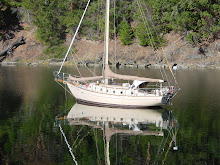La Paz, BCS, Mexico
Man, is it hot!
Every day hits a high of around 40 degrees, cooling off a little around 2 AM. Difficult to get up the energy to do anything.
In spite of the heat, the boat projects are progressing. My expanded solar array is almost complete - just a couple of wires to run and we should have a total of close to 700 watts of power available. Our genoa has had its UV protection re-stitched and we have added a strip of Sunbrella fabric so it will match the rest of the canvas on the boat. No, we did not actually do this work ourselves; we found an excellent sailmaker in town who had a suitable sail loft - not cheap, but done right. Now we have the sail back, in a sailbag, taking up room we don't have, in the galley.
After two tries, the dinghy repair dude has managed to get our dinghy floor to hold air again. Time will tell if this will last, but we have hopes.
 |
| Everything has to come out of the locker to get access to the new tuner location. |
 We hired a rigging specialist to go up the mast and inspect and tune the rigging, something that has not been done in many years. While he was up there, I had him install our new LED spreader lights and new LED steaming light (we have not had a working steaming light since we left BC). The spreader (deck) lights were relatively straight forward, only requiring some rewiring in the spreaders themselves - on one side there were three different wires spliced together to span a distance of about 3 feet, some of it just "speaker" wire - no wonder they didn't work any more. After that, the replacement of the burnt-out steaming light looked like a simpler challenge.
We hired a rigging specialist to go up the mast and inspect and tune the rigging, something that has not been done in many years. While he was up there, I had him install our new LED spreader lights and new LED steaming light (we have not had a working steaming light since we left BC). The spreader (deck) lights were relatively straight forward, only requiring some rewiring in the spreaders themselves - on one side there were three different wires spliced together to span a distance of about 3 feet, some of it just "speaker" wire - no wonder they didn't work any more. After that, the replacement of the burnt-out steaming light looked like a simpler challenge.
Unfortunately, as boat projects have a tendency to do, this simple light-bulb replacement idea turned into a major expense in both labour and materials. The steaming light fixture had a type of bulb not easily replace by any LED bulb currently on the market, so with this in mind, we purchased a new fixture and an appropriate LED bulb while we were in San Diego. When John (the rigger dude) went to install it, it became apparent that there was no power at the fixture near the top of the mast. After much trial and error we determined that the wire had been broken near the base of the mast where we could not easily get at it.

 |
| New LED spreader lights. |
Note that most of this work is done only in the morning hours. By noon, the heat is so brutal, nobody wants to do anything. One afternoon, we treated ourselves to a movie at the nearest Cinemex theatres (a half hour walk in the sun). Having heard of their higher-end Platino theatres, we splurged for the luxury option. The Platino theatres have their own ticket booth and concessions and only two theatres. The theatres themselves are hard to believe. Fully reclining armchairs with convenient tables and cub-holders, at least 5 feet between the rows, food service for anything from popcorn and soda to lasagna and alcoholic drinks, and the latest big screens and sound systems, all in air-conditioned comfort. We were happy to pay the price just to sit in the chairs for a couple of hours - the movie was just a bonus.
The movies are current, in English with Spanish subtitles. As we left the the theatre, they greet you with a tray of chocolates to thank you for your patronage.
What does all this cost you ask? Well, it is about twice the cost of the regular theatres, so it worked out to 80 pesos (around $6 CDN) per person. What can I tell you - we will definitely be back.
If you are thinking of moving to La Paz, we spotted this nice fixer-upper on the way to the theatre. It comes complete with the TV too.
{GMST}24|9.3042|N|110|19.6152|W|La Paz, BCS, Mexico|La Paz, BCS, Mexico{GEND}



































